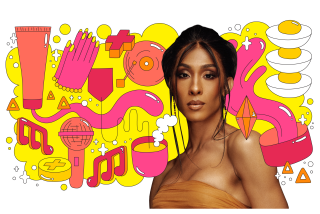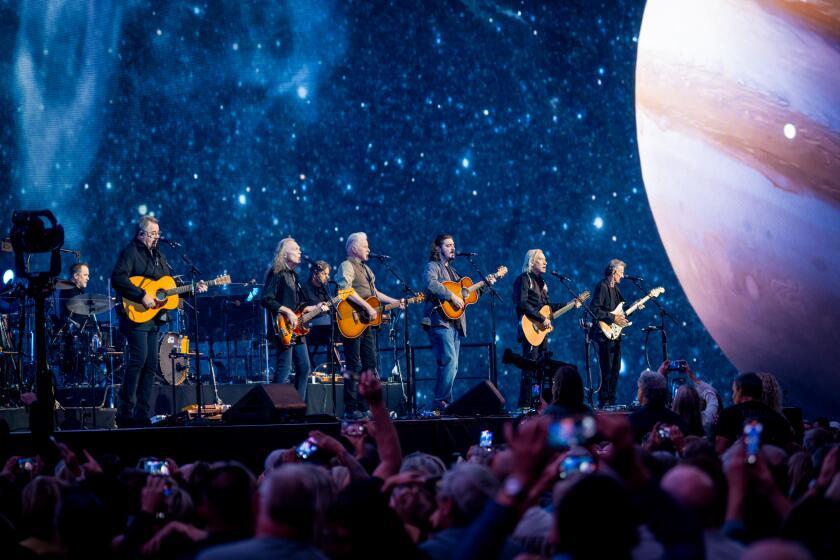How did ‘Drivers License’ become the song of 2021? By exulting in the power of teen-girl melodrama
Before she’s even sung a word, Olivia Rodrigo — newly heartbroken and eager to wallow in it — has beckoned the listener deep into her personal space.
“Drivers License,” the smash debut single by this 18-year-old actor and singer, opens with the sound of a car engine revving to life. As we hear the driver swing her door shut, the dinging of the car’s alarm morphs into a gently pulsing piano figure, and suddenly we’re in the passenger seat next to Rodrigo, who proceeds to unspool her tale of sorrow.
“I got my driver’s license last week / Just like we always talked about,” she sings, “’Cause you were so excited for me / To finally drive up to your house.” Here a slightly sinister bass line enters the mix, promising trouble like a patch of black ice ahead. “But today I drove through the suburbs,” she continues, “Crying ’cause you weren’t around.” For that last line, her voice drops to a mournful whisper, each ripple and crack suffused with the sting of betrayal.

“It’s almost too intimate, right?” asks Daniel Nigro, who cowrote “Drivers License” with Rodrigo and produced the song. “I love that. That’s on purpose.”
The by-design intensity has paid off: On Monday, Billboard announced “Drivers License,” which since its release in early January has been streamed more than half a billion times on Spotify and YouTube alone, had topped the Hot 100 for a sixth consecutive week — the first debut single in Billboard history to spend that long at No. 1 right out of the gate.
The song’s one-of-a-kind success has spawned countless think pieces, a sketch on last weekend’s “Saturday Night Live” and widespread conspiracy theorizing about Rodrigo’s involvement in a real-life love triangle behind the scenes at Disney.
Yet “Drivers License” doesn’t exist in a vacuum. Rodrigo’s swooning power ballad — it eventually builds to a cathartic bridge in which she tells her ex, “I still f— love you, babe” — is the latest spin on a rich tradition of teen melodrama in pop music that stretches back through Taylor Swift and Lorde (who proudly titled her most recent album “Melodrama”) to ’80s-era hits like Tiffany’s cover of “I Think We’re Alone Now” and Debbie Gibson’s “Lost in Your Eyes” to the lovesick girl groups of the early 1960s.
Before those young women were giving voice to the heightened emotions of late adolescence, there was Brenda Lee singing “I’m Sorry” at 15 and Judy Garland doing “Somewhere Over the Rainbow” at 17 in “The Wizard of Oz.” Emily Gale, a lecturer in pop history at Ireland’s University College Cork who’s writing a book called “Sentimental Songs for Sentimental People,” says she’s found sheet music for moody teen-geared material from as far back as the 1840s — including one epic tearjerker called “The Lament for the Blind Orphan Girl.”
There’s nothing quite so old as that on “Sad Girl Songs,” a Spotify playlist Rodrigo compiled for Valentine’s Day featuring her “favorite sad girl songs to drive around and cry to.” But among newish cuts like Clairo’s “Bags” and “Stay” by 21-year-old Gracie Abrams, the star of the Disney+ series “High School Musical: The Musical: The Series” peppers tunes from before she was born, such as Fiona Apple’s mid-’90s “Sullen Girl.”
In Apple’s day, her unabashed despair landed her on MTV and on the covers of glossy magazines; now, songs sung by and often directed toward teen girls are among the few that reliably cut through the hip-hop that crowds streaming charts.
How might we define teen melodrama as expressed across multiple generations? Piano recurs as a primary instrument even as production styles and technologies shifted over the decades, from the crisp R&B of the Shirelles’ “Will You Love Me Tomorrow” (cowritten by Carole King when she was 17) to the bleary, trap-inflected sound of Tate McRae’s Top 40 hit “You Broke Me First.”

Lyrically, these songs typically situate prodigious female suffering — “all of the anger and angst and sadness and longing” involved in a breakup, per Rodrigo’s description of her playlist — in mundane settings like the “white cars” and “front yards” of “Drivers License.”
And then there’s the singing, which embraces an explicit theatricality, somehow low-affect and overwrought at once, to bring the listener inside the narrator’s experience.
“My thing as a producer is seeing where you can take a voice — what are the limits of the range, what are the limits of the emotion?” says Nigro, who’s also worked with Carly Rae Jepsen, Hey Violet and Conan Gray. “What character are we putting on? A voice is never really a natural voice — it’s what the artist wants it to be.”
That use of character invites us to think about melodrama in music as we do in film and TV — in the great teen soaps of the late ’90s and early ’00s, such as “Dawson’s Creek” and “The OC,” or in Douglas Sirk’s gloriously over-the-top mid-’50s movies about women in crisis. Each employs artifice of various kinds to get at an emotional truth that feels real.
Each too has been dismissed by patriarchal gatekeepers, as author and Wesleyan University film-studies professor Jeanine Basinger observes when she tells The Times that the so-called women’s films of the ’30s and ’40s “were always down at the bottom of everybody’s critical ash heap.”
In that “SNL” sketch about “Drivers License,” which depicts a group of knuckleheaded guys playing pool as the song starts up on a jukebox, one of them sneers, “Sounds like it’s just some teen girl singing in her room to her piano.”

To other young people, though, that’s precisely the song’s value. “This is a time when everything in your life is a tragedy,” says Basinger. “Artists who speak directly to the interior private world of the teenager — that earnestness is like a dog whistle,” she adds, singling out Nicholas Ray’s “Rebel Without a Cause” as an example from film history. “Teenagers know their tribe.”
As closely as it adheres to classic teen melodrama, “Drivers License” tweaks the form in significant ways, beginning with Rodrigo’s use of that F-bomb in the bridge — a grasp at adulthood that earlier Disney performers had to wait until after they’d left the House of Mouse to execute.
Nigro, who’s 38, views the word’s appearance in the song as part of a larger trend toward specificity in pop songwriting. “I’ve told Olivia and Conan that this is the difference in our generations,” the producer says. “When I was 21, it was cool to listen to Radiohead, and half the time you didn’t even understand what the words were. Whereas nowadays people” — particularly those accustomed to the modern confessional booth that is social media — “are so much more in tune with the lyrics and the concept.”
Swift, with her emphasis on storytelling (and her own judicious swearing), has been a crucial figure in this shift; no musician has done more than she has to shape how Gen Z talks about itself. You can detect Swift too in the way “Drivers License,” like so many highly coded Swift songs, engages a celebrity meta-narrative regarding Rodrigo’s relationship with one of her “High School Musical” castmates (and his subsequent relationship with a third Disney star).
That intertextuality extends to “Drivers License’s” production, which is quieter and more nuanced than in the teen melodrama of years past. To some extent the song’s minimalist sound simply reflects changes in popular taste — the overall move away, for example, from blistering bubble-grunge guitars as heard in mid-’00s music by Ashlee Simpson and Lindsay Lohan.
But the intimacy of a song like Rodrigo’s also flatters an audience grown familiar with the old tricks; it tells listeners they’re sophisticated enough not to need everything spelled out for them. “With Instagram and this and that, everything is a show now,” says Kara DioGuardi, the longtime pop songwriter who penned hits for both Lohan and Simpson. “So when someone has real emotion in their music, why cover it up with a bunch of sound?”
Gale, from University College Cork, points to another distinguishing aspect of “Drivers License,” which is that it puts a woman in the literal driver’s seat. “The vehicle in pop music has been such an important marker of freedom, but access to it has been gendered for so long,” she says. Half a century after “Leader of the Pack,” Gale adds, Rodrigo “is claiming that freedom for herself.”
Indeed, “Drivers License” arrives amid a broader dismantling of established gender norms in pop. DioGuardi remembers when she was coming up, “I would try to pitch songs all the time about emotional vulnerability to men, and execs would be like, ‘No guy’s gonna sing that.’”
Today, though, teen melodrama courses through the music of sensitive male artists like Gray and Troye Sivan — and in a mode distinct from the borderline-misogynistic self-pity that defined much of the emo of the early 2000s.

Take “Heather,” Gray’s impassioned hit that has more than 400 million streams on Spotify, in which he longs to be the girl who’s got his crush “mesmerized while I die.”
Nigro, who produced “Heather” (and who played in an emo band called As Tall as Lions before he turned to studio work), says an artist’s gender has no bearing on how he goes about recording their vocals. “I don’t really think about it,” he says. “It’s all about the song for me.”
If the gender politics of teen melodrama are quickly evolving, the treatment of race is a different story. Since the ’60s, when Black girl groups helped turn the idea into commercial gold, teen melodrama has been largely embodied by young white women — one result of a society in which “Black children aren’t afforded the space to occupy the position of being young because the weight of the world is put on them,” according to Daphne Brooks, a veteran cultural critic and professor of African American studies at Yale.
“This gets deep feminist wonky, but it’s important historically to understand that Black women have never had the privilege of being private figures, going back to chattel slavery,” says Brooks, whose latest book is “Liner Notes for the Revolution: The Intellectual Life of Black Feminist Sound.” “So the ability to create these spaces of theatricalized intimacy don’t operate in the same way.”
Still, Brooks sees signs of change in the acclaim for the movie “Sylvie’s Love,” a sumptuous, Sirk-style romance about two young music obsessives in late-’50s Harlem, and for the debut album by Arlo Parks, a 20-year-old Black woman from London who writes dreamily introspective songs about the pleasures and torments of young love.
Also: Rodrigo, who grew up in Temecula, is Filipino American, a fact that hasn’t escaped fans on social media who’ve cheered her success within a pop tradition dominated by artists like the “blonde girl” she mentions in “Drivers License.”
Given the phenomenon the song has become, Rodrigo is almost certain to try to duplicate its emotional intensity in her followup, whenever it comes. And not just her: Nigro says that in the weeks since “Drivers License” blew up, he’s heard from friends in the industry who’ve told him record labels aren’t asking for uptempo party songs right now.
“They’re like, ‘Wow, now I can write a big heart-on-your-sleeve ballad and my label won’t get mad.’”
More to Read
The biggest entertainment stories
Get our big stories about Hollywood, film, television, music, arts, culture and more right in your inbox as soon as they publish.
You may occasionally receive promotional content from the Los Angeles Times.











